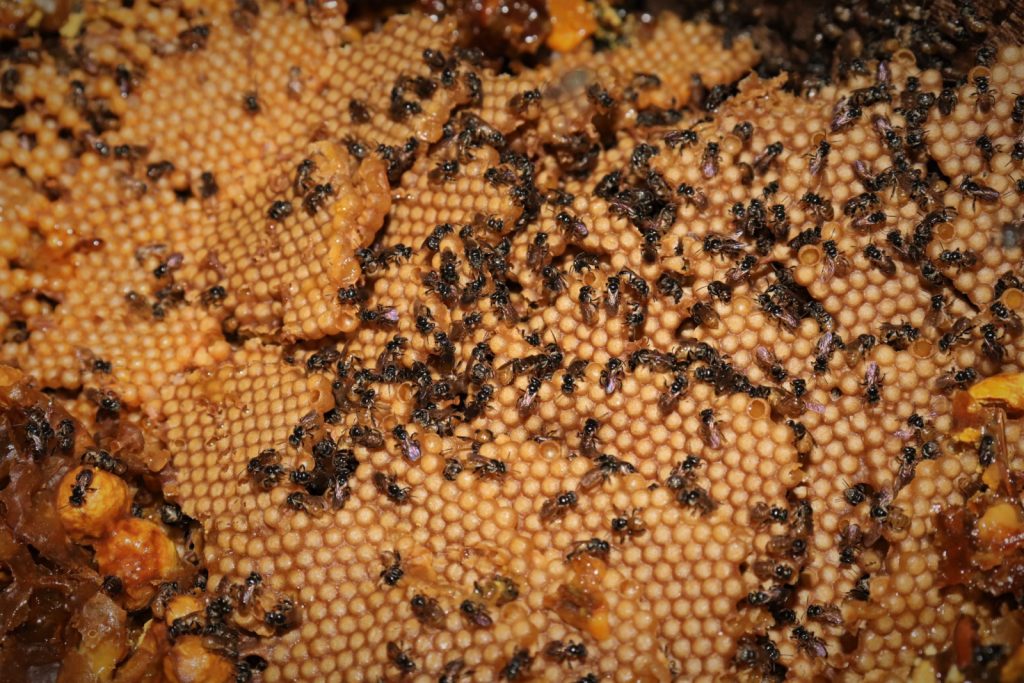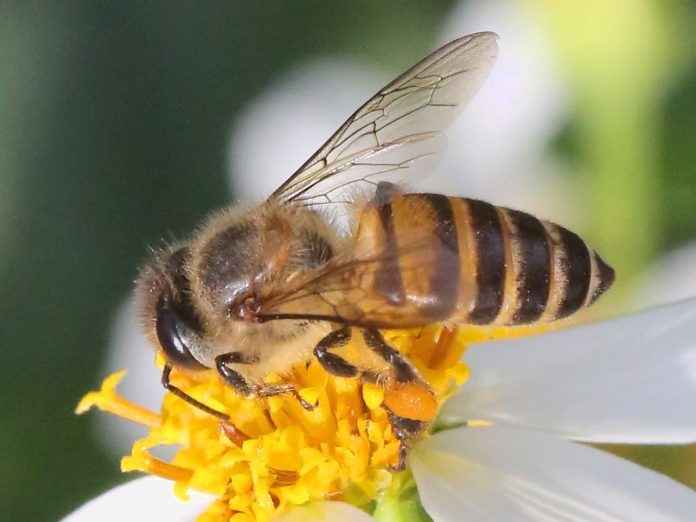Today I enjoyed a teaspoon of honey that I could proudly claim was a product of our garden. Popoy, our gardener, found a huge beehive wrapped around a branch of a native babayan tree. He was gathering some of the fruits of the babayan — which makes for a good vegetable dish. It perks up a humble pinakbet with linamnam (how do you say that in English?), especially when you flavor the sayce with the cream of coconut milk. The babayan fruits themselves don’t look appetizing, by the way. They curl up into what look like elongated little green worms. Imagine cooking a whole pot of these! They are delicious, no doubt, but you can’t help but think of them as hundreds of intertwined larvae, so I prefer to mix them with pinakbet.
Let’s go back to the honeybees now. With the help of a friend, our gardener Popoy made a torch-like stick and tied at the stick’s tip a ball of dried cogon grass. He put a lighted cigarette at the very core of the ball of dried cogon to produce smoke. As he reached the branch with the beehive, he started blowing the lighted cigarette at the core of the ball of grass to produce some smoke. With the smoke, he managed to shoo away the hardworking friends, so as to be able to harvest the huge mound of beehive without being stung by the bees. I was told that the fried empty beehives sauteed in coconut oil also makes for an excellent dish.
Popoy succeeded in filling up two big bottles of the sweet liquid that thousands of bees had obtained from the nectar from the mango blossoms — a process that facilitated the pollination of the flowers into a bounty of sweet-smelling mangoes of the kinalabaw and piko varieties.
Imagine sipping a strong cup of coffee sweetened by this delicious honey obtained by a whole army of bees from the nectar of mango flowers! The flavor is divine; it comes with a scent of mango blossoms. One little teaspoon of the processed nectar is enough to sweeten a whole mug of a brewed mix of Robusta and Arabica coffee from Batangas and Benguet, respectively.
I felt a little guilty about robbing these creatures of the product of their hardwork. But yesterday, Popoy told me the army of bees simply transferred to a nearby tree and started building a new hive. I can only surmise that they had succeeded in saving their queen and in constructing a new colony.
Earlier this week, I chanced upon a video of a French talk show, where the host was interviewing a molecular biologist about the origin of the bacteria that facilitated the making of the ancient versions of cheese from milk.
The young scientist said, “Imagine these little winged insects, finding no more blossoms to get nectar from. They chance upon ripe fruits oozing with juice that had fermented into alcohol and start collecting the alcoholic liquid, along with the bacteria that facilitated the fermentation process. (Yes, Virginia, the first alcoholics were bees!)
One day, some of these alcohol laden bees fall into a whole bucket of milk that was also beginning to ferment. The farmers used to throw away the old milk that soured up and got spoiled. But the bacteria carried by the bees that had fallen into the old milk soon mixed with the bacteria in the milk and mutated into new variants of bacteria that processed the old milk into something the farmers found delicious. This was the little accident caused by our hardworking friends that had brought about the evolution of these new equally hardworking microscopic little creatures.

I asked my AI friend, Chat GPT, to identify these creatures for me. The answer is: “They are what we call lactic acid bacteria. They help in the fermentation of milk into cheese. Some of the specific species of lactic acid bacteria commonly used in cheese-making include Lactococcus lactis, Streptococcus thermophilus, and Lactobacillus bulgaricus. These bacteria help convert lactose (the sugar in milk) into lactic acid, which causes the milk proteins to coagulate and form curds, the basis of cheese. The type and amount of bacteria used in cheese-making can affect the flavor, texture, and aroma of the final cheese product.” Wow!
Thanks to our hardworking bees, we not only have honey to enjoy. Now we also have a huge variety of cheeses produced by countries that produce milk from cows, goats, sheep and yes—even from camels.
France is renowned for its wide variety of delicious cheeses, my favorites among them being:
- Brie: A soft cow’s milk cheese from the Île-de-France region, with a mild, buttery flavor and a bloomy rind.
- Camembert: A soft cow’s milk cheese from Normandy, with a creamy texture and a rich, earthy flavor.
- Roquefort: A blue cheese made from sheep’s milk in the Aveyron region, with a tangy, salty flavor and a crumbly texture.
- Comté: A hard, nutty cow’s milk cheese from the Franche-Comté region, often used as a grating cheese.
- Chevre: A family of goat’s milk cheeses from various regions of France, with a tangy, acidic flavor and a range of textures from soft and spreadable to firm and crumbly.
- Reblochon: A soft cow’s milk cheese from the Haute-Savoie region, with a nutty, earthy flavor and a washed rind.
- Emmental: A firm, nutty cow’s milk cheese from the Jura region, with large holes (known as “eyes”) and a pale yellow color.
Lest my Italian friends rise up in arms, I will not, for the life of me, forget citing the best-known Italian cheeses in the world:
- Parmigiano-Reggiano: A hard, aged cow’s milk cheese from the Emilia-Romagna region, with a nutty, salty flavor and a granular texture. Often grated over pasta dishes or used in risottos.
- Mozzarella: A soft, fresh buffalo or cow’s milk cheese from Campania, with a mild, milky flavor and a stretchy texture. Often used in salads, pizzas, and pasta dishes. (Take note, we produce mozzarella from carabao milk in the Philippines.)
- Gorgonzola: A blue cheese made from cow’s milk in the Lombardy region, with a creamy, pungent flavor and a crumbly texture. Often served as a dessert cheese or in pasta dishes.
- Pecorino Romano: A hard, salty sheep’s milk cheese from Lazio, often used in Italian cooking as a grating cheese, especially on pasta dishes.
- Ricotta: A fresh, soft cheese made from cow, sheep, or goat’s milk, with a mild, slightly sweet flavor and a creamy texture. Often used in desserts, pastries, and pasta dishes.
- Fontina: A semi-soft cow’s milk cheese from the Aosta Valley region, with a mild, nutty flavor and a supple texture. Often used in fondues or melted on sandwiches.
- Provolone: A semi-hard cow’s milk cheese from southern Italy, with a mild, buttery flavor and a smooth texture. Often used in sandwiches or melted on pizzas.
- Not to be outdone in the production of exquisite cheeses is Spain, of course. Their best know varieties are:
- Manchego: A sheep’s milk cheese from the La Mancha region, with a distinctive herringbone rind and a nutty, slightly sharp flavor. Often enjoyed with quince paste or membrillo.
- Mahón: A cow’s milk cheese from the island of Menorca, with a buttery texture and a tangy, fruity flavor. Often eaten on its own or used in sandwiches.
- Idiazábal: A sheep’s milk cheese from the Basque region, with a smoky flavor and a firm, slightly oily texture. Often used in salads or melted on toast.
- Tetilla: A cow’s milk cheese from Galicia, with a mild, buttery flavor and a creamy texture. Often used in empanadas or grilled cheese sandwiches.
- Cabrales: A blue cheese made from cow’s, sheep’s, and/or goat’s milk in the Asturias region, with a strong, spicy flavor and a crumbly texture. Often served with walnuts or honey.
- Garrotxa: A goat’s milk cheese from Catalonia, with a mild, nutty flavor and a slightly crumbly texture. Often served with crackers or bread.
- San Simón: A cow’s milk cheese from Galicia, with a smoky flavor and a soft, creamy texture. Often enjoyed on its own or used in cooking, such as in gratins.
The next time you get to enjoy any of them, please don’t forget to pay a little homage to our humble, hardworking friend—the honeybee.
Bishop Pablo Virgilio David is prelate of the Diocese of Kalookan and currently president of the Catholic Bishops’ Conference of the Philippines.









